The Asian century is set to begin

Simply sign up to the Global Economy myFT Digest -- delivered directly to your inbox.
Economists, political scientists and emerging market pundits have been talking for decades about the coming of the Asian Age, which will supposedly mark an inflection point when the continent becomes the new centre of the world.
Asia is already home to more than half the world’s population. Of the world’s 30 largest cities, 21 are in Asia, according to UN data. By next year, Asia will also become home to half of the world’s middle class, defined as those living in households with daily per capita incomes of between $10 and $100 at 2005 purchasing power parity (PPP).
Since 2007, Asians have been buying more cars and trucks than people in any other region — by about 2030 they will be buying as many vehicles as the rest of the world combined, according to LMC Automotive.
Leaders in the region are beginning to talk more openly about the shift. “Now the continent finds itself at the centre of global economic activity,” Narendra Modi, prime minister of India, told the last annual meeting of the Asian Infrastructure Investment Bank. “It has become the main growth engine of the world. In fact, we are now living through what many have termed the Asian Century,” he said.
So when will the Asian Age actually begin?
The Financial Times tallied the data, and found that Asian economies, as defined by the UN trade and development body Unctad, will be larger than the rest of the world combined in 2020, for the first time since the 19th century. The Asian century, the numbers show, begins next year.
To put this in perspective, Asia accounted for just over a third of world output in 2000.

To make its calculations, the FT examined IMF data based on gross domestic product after adjusting for price differences in different countries. This method, which assesses economies by PPP, is widely considered the most relevant measure as it takes into account what people can actually buy in developing countries where prices are often cheaper.
Even at market exchange value, Asia still accounts for 38 per cent of global output, up from 26 per cent in the early 2000s.
What lies behind Asia’s economic eclipse of the rest of the world? The rise of China and India explains a large part of this trend. China is now a bigger economy at PPP than the US, accounting for 19 per cent of world output this year, more than double the 7 per cent recorded in 2000. India is now the world’s third-largest economy, with a GDP about double the size of either Germany or Japan, both of which had economies larger than India’s on a PPP basis in 2000.
The world’s imminent entry to an Asian age is coming not just because of its two largest economies, but also thanks to growth among smaller and midsize countries.
Indonesia is on track to become the world’s seventh-largest economy at PPP by 2020, and will have overtaken Russia by 2023 as the sixth biggest.

Vietnam, one of Asia’s fastest-growing economies, has overtaken 17 countries in a ranking of economies in PPP terms since 2000, including Belgium and Switzerland. The Philippines is now a larger economy than the Netherlands while Bangladesh has overtaken 13 other economies in the past 20 years.
Asia’s recent surge, which began with Japan’s postwar economic surge, represents a return to a historical norm. Asia dominated the world economy for most of human history until the 19th century.
“Around the end of the 17th century, Europe was looking with admiration and envy at a region of the globe which concentrated . . . more than two-thirds of the world’s gross domestic product, and three-quarters of the world’s population,” said Andrea Colli, professor of economic history at Bocconi University in Italy.

In the 18th century, India’s share of the world economy was as big as Europe’s, according to Indian politician and author Shashi Tharoor.
Then, for three centuries, Asia’s place in the world shrank as western economies took off, powered by what academics refer to as the Scientific Revolution, then the Enlightenment and the Industrial Revolution.
“What you are looking at is the great reversal,” says Joel Mokyr, professor at Northwestern University. “Between 1500 and 1750 Europe changed dramatically; the rest of the world did not.”
By the 1950s, Asia accounted for less than 20 per cent of world output, despite hosting more than half the world’s population.
“In the 19th century, Asia was transformed from the world’s manufacturing centre into classic underdeveloped economies exporting agricultural commodities,” said Bob Allen, professor of economic history at NYU, Abu Dhabi, who was formerly at the University of Oxford.
But in recent decades that trend has been reversed.
The dramatic rise of Japan and South Korea, the first countries in Asia to catch up with the west, has been “dwarfed” by China’s take-off following the country’s introduction of market-oriented reforms under Chinese leader Deng Xiaoping in the late 1970s.
In just a couple of generations, a “winning mix of integration with the global economy via trade and foreign direct investment, high savings rates, large investments in human and physical capital, and sound macroeconomic policies” contributed to Asia’s economic leap forward, according to the IMF’s latest regional outlook compiled by a team led by Koshy Mathai.
“The west's two-century epoch as global powerhouse is at an end,” argues Kishore Mahbubani in his latest book “Has the West Lost It?”
Over the past five decades, hundreds of millions of people in Asia have been lifted out of poverty and many Asian economies have graduated to middle-income or advanced economic status, according to World Bank definitions.

Asia remains poorer than the rest of the world, but the gap is narrowing. China’s GDP per capita at PPP is still only about one-third of that of the US, and about 44 per cent of that of the EU. India has a GDP per capita at PPP of only about 20 per cent that of the EU, according to IMF data.
But India and China’s per-capita income gap with the US and Europe has narrowed dramatically since 2000. Over that period, China has become nearly five times richer than the average per capita output of sub-Saharan Africa. The two regions were at similar levels in the mid-1990s.
By any measure, Asia is about to reoccupy the centre of the global economic stage. When it does, “the world will have come full circle”, Prof Allen said.
Comments